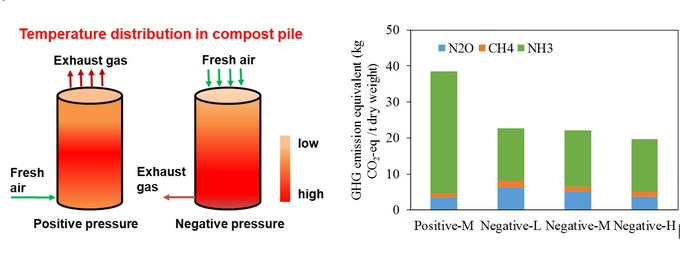News&Events
- Home >> News&Events >> Events
The negative pressure aeration for ammonia abatement in composting and in-situ mitigation potential of ammonia and GHG release by different additives
As a large agricultural country with a burgeoning human population, China produces huge amounts of agricultural organic matter every year. Composting as an important technology for agricultural organic waste recycling is widely applied worldwide especially in China where produces 30Mt commercial organic fertilizer every year handling about 100 Mt waste by composting technology. However, traditional composting would be associated with serious NH3 emission (40-70% to total N), as well as a source of environmental impact through the emission of the greenhouse gases (GHG) nitrous oxide (N2O) and methane (CH4).
Prof. Ma’s group developed new composting system fund that negative pressure aeration changed the temporal distribution of oxygen and temperature. With the same flow rate, the Negative-M treatment maintained a longer thermophilic period, accelerating organic matter degradation (47.6% in treatment Negative-M and 41.4% in Positive-M) and the maturity of feedstock (germination index was 105.9% in Negative-M and 58.5% in Positive-M). Ammonia emission was significantly reduced by ~55% in composting with negative pressure aeration compared to the positive pressure aeration treatment. Even though both CH4 and N2O emission were greater from the negative pressure aeration treatments, the global warming potential was significantly reduced in treatments with negative pressure aeration because of the lower NH3 emission (an indirect N2O source). This indicates the benefit of NH3 emission mitigation was larger than the increase in CH4 and N2O emissions.

Fig. 1. Temperature distribution and Global Warming Potential in negative and positive pressure aeration composting treatments. Treatment Positive-M (a), Negative-L (b), Negative-M (c) and Negative-H (d). (Positive-M: Positive pressure aeration with medium flow rate 0.50 L/min/kg dry weight; Negative-L: Negative pressure aeration with low flow rate 0.25 L/min/kg dry weight; Negative-M: Negative pressure aeration with medium flow rate 0.50 L/min/kg dry weight; Negative-H: Negative pressure aeration with high flow rate 0.75 L/min/kg dry weight).
To achieve in-situ associate abatement of both NH3 and GHG and quantify the impact of different additives on NH3 and GHG emissions, a global meta-analysis was conducted using 105 studies with 303 paired comparisons, considering different composting feedstock properties. On average, additives reduced the total nitrogen (TN) loss (46.4%), NH3 (44.5%), N2O (44.6%) and CH4 (68.5%) emissions, and total GHG emissions expressed as global warming potential (GWP) (54.2%) during composting. Chemical, physical and microbial additives all significantly reduced TN loss and NH3 emission; however, the strongest effect was observed for chemical additives under the condition of low moisture content (≤ 65%), low C/N ratios (≤ 20) or alkalinity (pH > 7.5). Specifically, PO43- and Mg2+ salt had the greatest mean mitigation for TN loss (68.0%) and NH3 emission (62.0%). In contrast, physical additives (e.g. biochar and zeolite) were more effective at reducing the total GHG emissions (67.2%) compared with chemical additives because of the greater mitigation of N2O emission. Low moisture content (≤ 65%) or low C/N ratios (≤ 20) enhanced the effectiveness of chemical additives in reducing TN loss and NH3 emission. Physical additives were suggested to be more effective in reducing N2O emission at low moisture content (≤ 65%) or high C/N ratios (> 20 to ≤ 30). The magnitude of the mitigation of TN loss and NH3 emission increased as the dosage rate of PO43- and Mg2+ salt/superphosphate increased between 0 to 20%. This meta-analysis suggests that an optimized combination of chemical and physical additives tailored to feedstock characteristics and application dosage may be a promising approach for the synergistic mitigation of NH3 and GHG emissions.

Fig.2. Effects of additives with different modes of mitigation on TN loss, NH3, N2O, CH4 emissions and GWP. Mean effect values and 95% confidence intervals are shown. The total number of studies and pairs (in parentheses) for each treatment are displayed on the right-hand side of the results.
The research findings were published on Journal of cleaner production with the title of“Composting with negative pressure aeration for the mitigation of ammonia emission and global warming potential”and“Mitigation of ammonia, nitrous oxide and methane emissions during solid waste composting with different additives: A meta-analysis”The work was supported by the National Key Research and Development Program of China [2018YFC0213300], Key Research Program of the Chinese Academy Sciences [ZDRW-ZS-2016-5] and Hebei Dairy Cattle Innovation Team of Modern Agroindustry Technology Research System [HBCT2018120206].
Wang, X., Bai, Z., Yao, Y., Gao, B., Chadwick, D., Chen, Q., Hu, C., Ma, L., 2018. Composting with negative pressure aeration for the mitigation of ammonia emissions and global warming potential. Journal of Cleaner Production, 195, 448-457.
Cao, Y., Wang, X., Bai, Z., Chadwick, D., Misselbrook, T., Sommer, S., Qin, W., Ma, L., 2019. Mitigation of ammonia, nitrous oxide and methane emissions during solid waste composting with different additives: A meta-analysis. Journal of Cleaner Production, 235, 626-635.
Link: https://doi.org/10.1016/j.jclepro.2018.05.146
https://doi.org/10.1016/j.jclepro.2019.06.288
(Xuan Wang, Yubo Cao)
